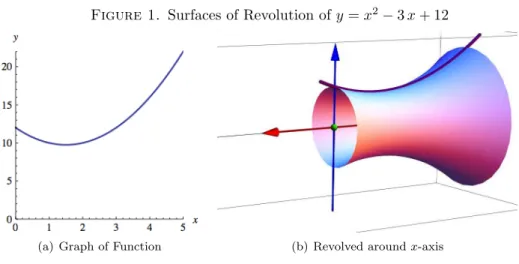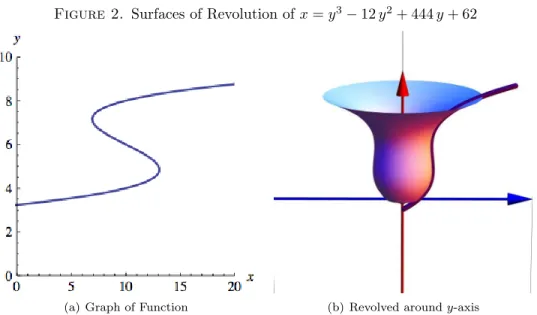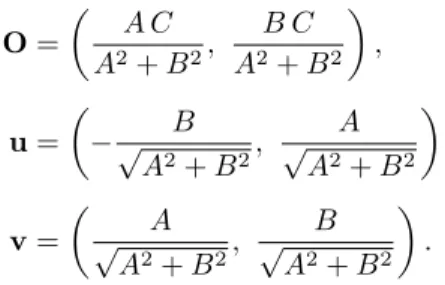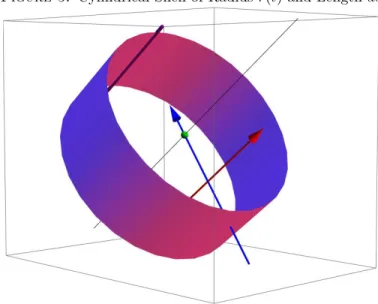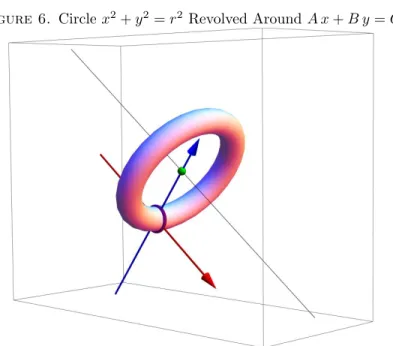A GRAPH ABOUT ANY LINE
EDRAY HERBER GOINS AND TALITHA M. WASHINGTON
Abstract. We discuss a general formula for the area of the surface that is generated by a graph [t0, t1]→R2 sendingt7→ x(t), y(t)revolved around
a general lineL: A x+B y=C. As a corollary, we obtain a formula for the area of the surface formed by revolvingy=f(x) around the liney=m x+k.
1. Introduction
You spin me right round, baby, right round! – Dead or Alive
Many students in advanced Calculus courses learn how to compute the area of a surface of revolution. Perhaps the best known example goes something like this: For functions y = f(x) differentiable on the interval a ≤x ≤ b, the area of the surface of revolution of its graph about thex-axis is given by the integral
(1) 2π Z b
a | y|
s
1 +
dy dx
2
dx= 2π Z b
a f(x)
q
1 +f′(x)2dx.
An example of this type of rotation can be found in Figure 1 below.
Figure 1. Surfaces of Revolution ofy=x2
−3x+ 12
(a) Graph of Function (b) Revolved aroundx-axis
2010Mathematics Subject Classification. 26B15, 28A75.
Key words and phrases. Surfaces; Area; Rotation.
This exposition is dedicated to the inquisitive students in advanced Calculus courses who enjoy seeing mathematics beyond those topics covered in a standard textbook on the subject.
1
There is a similar formula for computing the area of the surface of revolution about they-axis, but one must work with the inverse functionx=g(y) and assume that it is a function differentiable on the intervalc≤y≤d:
(2) 2π Z d
c
|x|
s
1 +
dx dy
2
dy= 2π Z d
c g(y)
q
1 +g′(y)2dy.
As above, an example of this type of rotation can be found in Figure 2 below.
Figure 2. Surfaces of Revolution ofx=y3
−12y2+ 444y+ 62
(a) Graph of Function (b) Revolved aroundy-axis
These are special cases of graphs which can be parametrized by continuous func-tions, say x = x(t) and y = y(t), which are both differentiable on the interval
t0≤t≤t1. The area of the surface of revolution of parametrized graph is given by the integral
(3) 2π
Z t1
t0
|y(t)|
s
dx dt
2
+
dy dt
2
dt when revolved about thex-axis,
2π Z t1
t0
|x(t)|
s
dx dt
2
+
dy dt
2
dt when revolved about they-axis.
Such formulas can be found in Stewart’sCalculus [2, Section 8.2, Section 10.2]. A general discussion of integrals over surfaces can be found in Apostol’sCalculus [1, Chapter 12].
2. Rotations on a Slant
it’s our job to ease fears and provide the simplest explanations possible to even the most complex mathematical concepts. In this note, we’ll provide a relatively simple proof of the following generalization.
Proposition 1. Consider the graph parametrized by functions x=x(t) and y =
y(t), both differentiable on the interval t0 ≤ t ≤ t1. The area of the surface of revolution of this graph, when revolved about a lineL: A x+B y=C, is given by the integral
(4)
2π Z t1
t0
r(t)
s
dx
dt 2
+
dy
dt 2
dt
= 2π Z t1
t0
r(t)
q
x′(t)2+y′(t)2dt
in terms of the nonnegative function
(5) r(t) =
A x(t) +B y(t)−C
√
A2+B2 .
Before we present the proof, we explain how to use this generalization to derive Equations (1) and (2). For the former, the graph ofy=f(x) can be parametrized by the functions x(t) = t and y(t) = f(t) on the interval a ≤ t ≤ b. The x -axis is simply the line L : y = 0, so we may choose (A, B, C) = (0,1,0). Then
r(t) = |f(t)|, and we find Equation (1). For the latter, the graph ofx=g(y) can be parametrized by the functionsx(t) =g(t) andy(t) =ton the intervalc≤t≤d. The y-axis is simply the line L : x = 0, so we may choose (A, B, C) = (1,0,0). Thenr(t) =|g(t)|, and we find Equation (2).
On pages 551 and 552 of Stewart’s Calculus [2], there is a Discovery Project entitled “Rotations on a Slant”, where a differentiable functiony=f(x) is rotated about the liney=m x+kexpressed in point-slope form. As a solution to Exercise 5, we recover the following result.
Corollary 2. Consider a functiony=f(x)which is differentiable on the interval
a ≤x ≤b. The area of the surface of revolution of its graph about the line y =
m x+k is given by the integral
(6)
2π Z b
a |
y−m x−k|
s
1 + (dy/dx)2
1 +m2 dx
= 2π Z b
a
f(x)−m x−k s
1 +f′(x)2
1 +m2 dx.
We explain why this corollary is true. As above, writey=f(x) in terms of the functionsx(t) =tandy(t) =f(t) on the intervala≤t≤b. The lineL: y=m x+k
can be expressed in the formA x+B y=C upon choosing (A, B, C) = (−m,1, k), so that we have the nonnegative function
(7) r(t) =
A x(t) +B y(t)−C
√
A2+B2 =
f(t)−m t−k
√
Proposition 1 implies that we have the area
(8)
2π Z t1
t0
r(t)
q
x′(t)2+y′(t)2dt
= 2π Z b
a
f(x)−m x−k
√
1 +m2 q
1 +f′(x)2dx.
Some examples of this result can be found in Figure 3 below.
Figure 3. Revolutions ofy=x2
−3x+ 12 Around Lines
(a)y= 0 (b) 3x+ 4y= 0
3. Proof of Main Result
The idea for the proof will be to create a new coordinate system using the line
Las an axis. To this end, let’s define the following three points in the plane:
(9)
O=
A C
A2+B2, B C A2+B2
,
u=
−√ B
A2+B2, A
√
A2+B2
,
v=
A
√
A2+B2, B
√
A2+B2
.
Each of these points has a geometric interpretation. The first pointO will act as our “origin”; it lies on the line L. The second point ulies along the direction of
L, while the third pointv lies perpendicular toL. A diagram of these points with respect toL can be found in Figure 4.
Figure 4. Plot of0, u, andv on the LineL: A x+B y=C
In order to prove Proposition 1, we will prove a series of results.
Lemma 3. {u,v} forms an orthonormal basis forR2.
case for the vectors above because we have the identities
(10)
u·v=−√ B
A2+B2 A
√
A2+B2+ A
√
A2+B2 B
√
A2+B2
=−B A+A B
A2+B2 = 0,
kuk=
s
−√ B
A2+B2 2
+
A
√
A2+B2 2
=
s
B2+A2 A2+B2 = 1,
kvk=
s
A
√
A2+B2 2
+
−√ B
A2+B2 2
=
s
A2+B2 A2+B2 = 1.
Next, we’ll use these three pointsO,u, andvto decompose points (x, y) in the plane along the axes defined above.
Lemma 4. Every point in the plane can be decomposed into parts that lie on the lineL and parts that lie perpendicular to the line. Explicitly,
(11) x, y=
O+−√B x+A y
A2+B2 u
| {z }
on the lineL
+
A x+B y−C
√
A2+B2 v
| {z }
perpendicular to the lineL .
In order to prove this, we must perform some algebra. The decomposition holds because we have the sum
(12)
O =
A C A2+B2 ,
B C A2+B2
−B x+A y
√
A2+B2 u =
B2x−A B y
A2+B2 ,
−A B x+A2y A2+B2
A x+B y−C
√
A2+B2 v =
A2x+A B y
−A C
A2+B2 ,
A B x+B2y
−B C
A2+B2
Sum of Points =
A2+B2 A2+B2x,
A2+B2 A2+B2y
Moreover, the sum of the first two points
(13) O+−√B x+A y
A2+B2 u=
B2x−A B y+A C A2+B2 ,
−A B x+A2y+B C A2+B2
lies on the lineL:
(14)
A
B2x
−A B y+A C A2+B2
+B
−A B x+A2y+B C A2+B2
= A B
2x
−A2B y+A2C+
−A B2x+A2B y+B2C
A2+B2 =C.
The third point is perpendicular to the line becausev is orthogonal tou. Next, we put these results together to compute a useful formula.
Lemma 5. The distance from a point(x, y)to the line Lis given by
(15) r=
A x+B y−C
√
To prove this, we essentially use the Pythagorean Theorem: we project any point (x, y) in the plane into two directions, one along the line L and the other perpendicular to it. The distance from this point to the line is simply the length of the perpendicular direction, that is, the length of the vector alongv.
(16) r=
A x+B y−C
√
A2+B2 v
=
A x+B y−C
√
A2+B2 v=
A x+B y−C
√
A2+B2 .
Proof of Proposition 1: Say that we have two functionsx=x(t) and y=y(t), both differentiable on the intervalt0≤t≤t1, as well as a lineL: A x+B y=C. According to Lemma 5, the distance from a point (x, y) = x(t), y(t) to the line
Lis given by the function
(17) r(t) =
A x(t) +B y(t)−C
√
A2+B2 .
This will act as the radius of rotation around the line. A small arc length along the graph at this point is given by the differential
(18) ds=
q
dx2+dy2=
s dx dt 2 + dy dt 2 dt= q
x′(t)2+y′(t)2dt.
This will act as the width of the cylindrical shell. (See Figure 5 for an illustration.) Putting these together, the area differential of the surface of revolution is
(19)
dArea = 2π r(t)ds
= 2π
A x(t) +B y(t)−C
√
A2+B2
q
x′(t)2+y′(t)2dt,
so that the desired area of revolution is given by
(20)
Area = 2π Z t1
t0
r(t)ds
= 2π Z t1
t0
A x(t) +B y(t)−C
√
A2+B2
q
x′(t)2+y′(t)2dt.
4. Example
We illustrate these ideas with an example. Say that we wish to rotate the circle
x2+y2 = r2 of radius r around the line A x+B y = C – but we’ll assume for
simplicity that
(21) R= √ C
A2+B2 > r.
As shown in Figure 6, this is just a torus. We’ll show that the area of this surface is 4π2R r.
To begin, we’ll plot the circle using the functionsx(t) =rcostandy(t) =rsint
fort0≤t≤2π+t0, wheret0 is an angle such that (22) cost0= √ A
A2+B2 and sint0= B
√
Figure 5. Cylindrical Shell of Radiusr(t) and Lengthds
The distance from a point x(t), y(t)to the line is given by the function
(23) r(t) =
A x(t) +B y(t)−C
√
A2+B2 =
cost0·r cost+ sint0·r sint−R
=R−rcos(t−t0).
(We have used the Angle Difference Formula cos(t−t0) = costcost0+ sintsint0. Recall thatR > r by assumption.) We have the arc length differential
(24) ds=
q
x′(t)2+y′(t)2dt=
q
−rsint2+rcost2dt=r dt.
The desired area of revolution is given by the integral
(25) 2π Z t1
t0
r(t)ds= 2π r Z 2π+t0
t0
R−rcos(t−t0)dt= 4π2R r.
References
[1] Tom M. Apostol.Calculus. Vol. II: Multi-variable Calculus and Linear Algebra, with
Appli-cations to Differential Equations and Probability. Wiley and Sons, 1969.
[2] James Stewart.Calculus: Early Transcendentals, Volume 6E. Cengage Learning, 2008.
Purdue University, Department of Mathematics, 150 North University Street, West Lafayette, IN 47907
E-mail address:egoins@math.purdue.edu
Howard University, College of Arts and Sciences, Department of Mathematics, 204 Academic Support Building B, Washington, DC 20059
